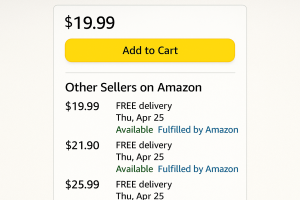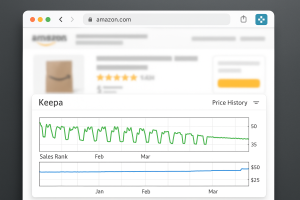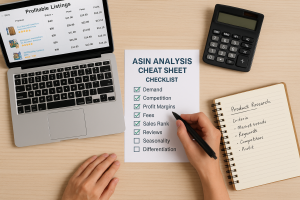Over the last decade, we’ve sold over $40 million on Amazon. But if there’s one thing that trips up new sellers time and time again, it’s this:
They buy the wrong products.
It’s easy to get excited about a listing that looks profitable… only to realize too late that it barely sells, Amazon itself is your biggest competitor, or you’re just not going to make money.
That’s why we created a simple, reliable process for analyzing any Amazon listing before you buy a single unit of inventory. And today, we’re sharing that exact process with you.
Whether you’re brand new or looking to level up your ecommerce game, this post will give you the exact steps to evaluate a product like a pro—without fancy tools or confusing jargon.
Why Listing Analysis is Your #1 Skill
Too many sellers think success on Amazon starts with finding “hot products.”
It doesn’t.
 It starts with understanding which listings are worth your money.
It starts with understanding which listings are worth your money.
Amazon has millions of products. Your job isn’t to find the flashiest or trendiest ones—it’s to find the ones that give you a consistent, predictable profit with minimal headaches.
Our approach—what we call The Wholesale Formula—is built on data, not hype. And it starts with analyzing each ASIN (Amazon Standard Identification Number) like a detective.
Here’s a quick and simple look at analyzing products.
The ASIN Analysis Checklist
Before placing a single order, try out this simple five-point checklist. If the listing checks all five boxes, you’re in good shape to move forward.
1. Two or More FBA Sellers
You want proof that third-party sellers are already making money.
 Look at the listing and check who’s selling the product. If there are at least two Fulfilled-by-Amazon (FBA) sellers, it’s a good sign.
Look at the listing and check who’s selling the product. If there are at least two Fulfilled-by-Amazon (FBA) sellers, it’s a good sign.
Why it matters:
This shows the brand isn’t exclusive to just one seller and that other resellers have successfully gotten permission to sell.
How to check:
Scroll down to the “Other Sellers on Amazon” section, or use the “Buy Box” to click and see all offers.
Pro Tip: Avoid listings where only one third-party seller is active. That often means they have an exclusive agreement with the brand, the brand itself, or a private label seller.
2. Buy Box Price of $14.95 or Higher
You’re here to make a profit, not pennies.
We recommend a minimum Buy Box price of $14.95. That gives you enough room for wholesale costs, Amazon fees, shipping, and a real profit margin.
Why $14.95?
Lower-priced items often carry the same Amazon fees as higher ones, but leave little room for margin.
What’s the Buy Box?
It’s the “Add to Cart” seller. If your price, stock, and performance align, you can rotate into it and make consistent sales.
3. No Amazon Retail Competing
This is huge.
If Amazon Retail is on the listing (and especially if they’re in the Buy Box), run.
They buy at rock-bottom prices directly from the manufacturer. You can’t beat them on price, and they rarely share the Buy Box.
How to tell:
On the seller list, look for “Ships from and sold by Amazon.com.” That’s Amazon Retail. Not FBA. Not a third-party.
Pro Tip: If Amazon Retail is present, skip the listing. They dominate with low prices and rarely run out of stock.
4. At Least 40 Sales Per Month
You don’t want slow-moving inventory.
Aim for products that sell a minimum of 40 units/month. That’s just over 1 per day, enough to generate meaningful profit without excessive risk. With that minimum, we are willing to split sales with multiple FBA sellers starting out.
How to check sales volume:
- Use Keepa (free version works!)
- Look at total reviews as a proxy—more reviews = more sales
- Look at rank history in Keepa’s “Sales Rank” graph—if it’s spiking regularly, sales are happening.
Pro Tip: If the sales rank is flat and high (e.g., above 100,000 in most categories), it’s probably not selling fast enough.
5. US-Based Brands Only (at First)
When you’re just getting started, stick to American brands sold by US companies.
No overseas buying. No risky suppliers.
Why this works:
- Easier communication
- Faster, cheaper shipping
- Safer legal protections
- Better chance of building real wholesale relationships
How to check:
- Google the brand name
- Visit their website
- Make sure they list a U.S. address or distribution
Pro Tip: Skip brands that are private label, generic, or clearly sourced from overseas (especially Chinese marketplaces). They’re often off-limits for new sellers.
Tools That Help You Analyze
You don’t need to spend money on expensive software. But a few free tools go a long way.
Keepa (Free Version)
We recommend installing Keepa as your first browser extension. It adds sales rank and price history charts directly to Amazon listings.
 Here’s what to look for:
Here’s what to look for:
- A consistent Sales Rank graph (spikes down = sales happening)
- A stable Buy Box price (no huge swings or undercutting)
- A product that stays in stock across sellers without crashing the price
Want to see Keepa in action? Check out our free training where we break it down in real time.
Download Our ASIN Analysis Cheat Sheet
We created a simple one-pager that walks you through the steps above for every listing you analyze.
It includes:
- The 5-point checklist
- Key data to track
- Links to tools
- Common red flags
Print it. Bookmark it. Use it every time.
 Red Flags to Watch Out For
Red Flags to Watch Out For
As you dig into listings, here are common traps that can derail a new seller:
 Amazon Retail is in the Buy Box
Amazon Retail is in the Buy Box
Amazon doesn’t share. Skip the listing.
 Only One Third-Party Seller
Only One Third-Party Seller
Likely an exclusive seller or brand owner. Not your opportunity.
 Product is Private Label
Product is Private Label
If the product name matches the seller name, it’s likely private label. These aren’t wholesale-friendly.
 Brand is Based Overseas
Brand is Based Overseas
Skip any products where the brand can’t be verified in the U.S. via Google or a .com website.
 Inconsistent Buy Box or Price Drops
Inconsistent Buy Box or Price Drops
If the price crashes every month or the Buy Box changes too much, you’re likely to lose money.
What To Do Next: Take Action
Reading this post is a great start. But what actually changes your life?
Taking action.
- Start analyzing 10 listings today using this checklist
- Practice identifying FBA sellers, Buy Box prices, and sales volume
- Bookmark Keepa and our Cheat Sheet
- Focus only on US-based brands with open distribution
Remember, you don’t need a warehouse. You don’t need experience. You just need the right formula—and we’ll show it to you.

Leave a Reply